Poland: Krakow (Auschwitz)
After another overnight train(8h), this time from Praha hl.n to Krakow Glowny train station, we arrived in Krakow.
Some facts abt Krakow(Crakow):
-Unlike most Polish cities, as it emerged from WW2 & communism nearly unscathed
-referred to as "Poland's beloved child now cast into international spotlight"

The Cloth Hall in the market square. To the right is the Town Hall tower.

St Mary's Church: every hour, a trumpet calls & cuts off abruptly in memory of the trumpeter who shot down by the Tarars as he attempted to warn the city of the Tartar's invasions
I came here mainly to see Auschwitz & Wieliezka salt mine. So here they are:
I took the recommended tour package that brought me to the 2 camps and the Jewish centre & synagogue in Auschwitz

Auschwitz basically have 2 concentration camps remaining(the 3rd camp was destroyed by the Nazis): the 1st & smaller Auschwitz I at Oswiecim, and the 2nd & larger Auschwitz II at Birkenau. It was the largest concentration camp in Europe during WW2.
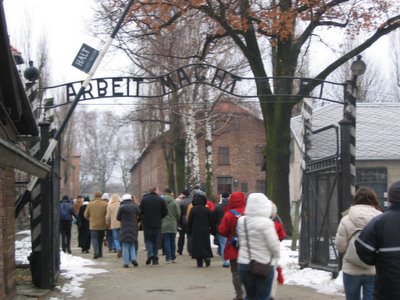
Entrance to Auschwitz I
Arbeit Macht Freig (Work shall set you Free)-bitter ironic description on camp's gate.

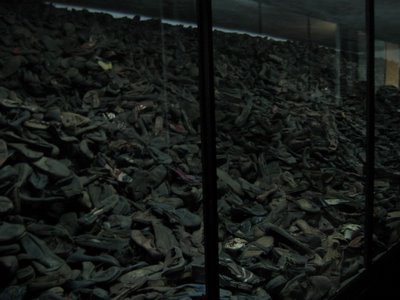
The barracks that once held Jews & Roma(gypsies) now showcase the ghastly remnants of those murdered: piles of suitcases, shoes, eyeglasses, hair(the most emotional for me)

Many were shot agst this wall

This is the cell of a priest, Father Maximilian, who willingly substitued another man's place for starvation & submitted himself to a more ghastly torture. Amazingly he survived but the Nazis exectued him by lethal injection. The priest became a strong symbol of faith in the face of persecution within the Catholic Church and was canonized by Pope John Paul II.

The 1st commandant of Auschwitz was tried & hanged here after the war

Entrance to the incinerator

Human bodies were shoved into the incinerator from here
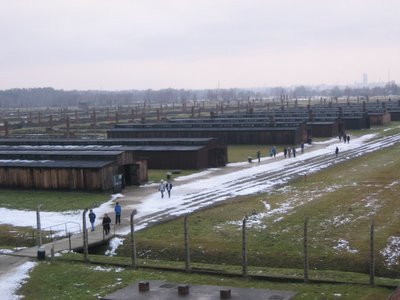
Auschwitz II: built when the massive influx of prisoners were brought to Auschwitz motivated the Nazis to pursue a more "efficient" means of killing. Nazis attempted to conceal their genocide by destroying the camps b4 it was liberated
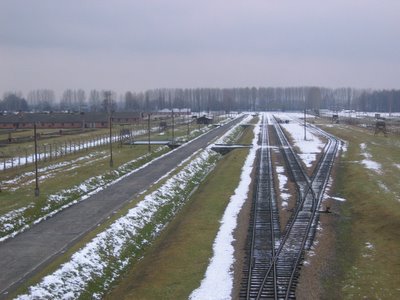
Trains from all over Europe arrive at this place bringing Jews, Roma and political prisoners

The beds

Toilet

After the concentration camps, we went to the Auschwitz Jewish centre which depicts pre-war Jewish life in town
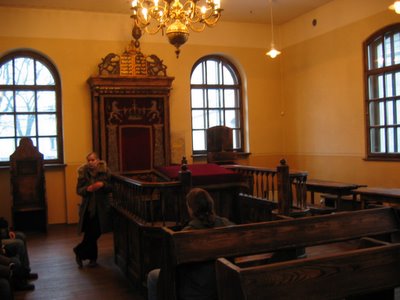
The only Jewish synagogue(reconstructed after the war) left in the town.
It's sad that there are no more jews in the town today though the town was a bustling Jewish centre b4 the war.
The person standing is our Polish guide.

After the Auschwitz tour, we walked around the Florianska street, which starts from the Barbican gate. (centre in pic)
Some facts abt Krakow(Crakow):
-Unlike most Polish cities, as it emerged from WW2 & communism nearly unscathed
-referred to as "Poland's beloved child now cast into international spotlight"

The Cloth Hall in the market square. To the right is the Town Hall tower.

St Mary's Church: every hour, a trumpet calls & cuts off abruptly in memory of the trumpeter who shot down by the Tarars as he attempted to warn the city of the Tartar's invasions
I came here mainly to see Auschwitz & Wieliezka salt mine. So here they are:
I took the recommended tour package that brought me to the 2 camps and the Jewish centre & synagogue in Auschwitz

Auschwitz basically have 2 concentration camps remaining(the 3rd camp was destroyed by the Nazis): the 1st & smaller Auschwitz I at Oswiecim, and the 2nd & larger Auschwitz II at Birkenau. It was the largest concentration camp in Europe during WW2.

Entrance to Auschwitz I
Arbeit Macht Freig (Work shall set you Free)-bitter ironic description on camp's gate.


The barracks that once held Jews & Roma(gypsies) now showcase the ghastly remnants of those murdered: piles of suitcases, shoes, eyeglasses, hair(the most emotional for me)

Many were shot agst this wall

This is the cell of a priest, Father Maximilian, who willingly substitued another man's place for starvation & submitted himself to a more ghastly torture. Amazingly he survived but the Nazis exectued him by lethal injection. The priest became a strong symbol of faith in the face of persecution within the Catholic Church and was canonized by Pope John Paul II.

The 1st commandant of Auschwitz was tried & hanged here after the war

Entrance to the incinerator

Human bodies were shoved into the incinerator from here

Auschwitz II: built when the massive influx of prisoners were brought to Auschwitz motivated the Nazis to pursue a more "efficient" means of killing. Nazis attempted to conceal their genocide by destroying the camps b4 it was liberated

Trains from all over Europe arrive at this place bringing Jews, Roma and political prisoners

The beds

Toilet

After the concentration camps, we went to the Auschwitz Jewish centre which depicts pre-war Jewish life in town

The only Jewish synagogue(reconstructed after the war) left in the town.
It's sad that there are no more jews in the town today though the town was a bustling Jewish centre b4 the war.
The person standing is our Polish guide.

After the Auschwitz tour, we walked around the Florianska street, which starts from the Barbican gate. (centre in pic)

0 Comments:
Post a Comment
<< Home